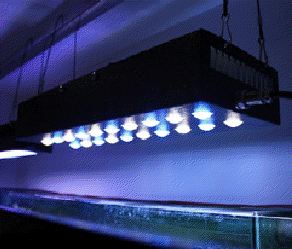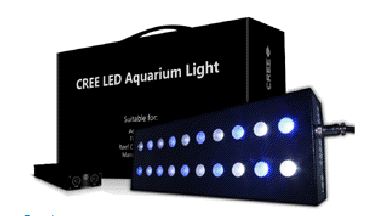Revised 7-25-12
 The Stark LED is a nice compact LED that has been making the rounds, especially in So. Cal Aquarium service circles.
The Stark LED is a nice compact LED that has been making the rounds, especially in So. Cal Aquarium service circles.
It looks nice, and its performance is reasonable, albeit a few years (3 generations) behind the leaders of the pack.
However the way it is marketed, one would think this was the latest and best technology, and it is not.
I also read on a forum (based on a customer citing this) whereby the moderator made a obscene remark about the FACT these are simply E.Shine LEDs, implying that the E.Shine LED is not what it is
 What is the importance of this you might ask?
What is the importance of this you might ask?
Well E.Shine is a large Chinese manufacturer of lighting, including these LED lights that are manufactured for branding by any company willing to purchase them; in this case the Stark LED such as the 60 watt model.
The FACTS are E.Shine does not have patent rights to the Cree emitters with the highest PUR output (please note I said PUR, not PAR and this is what REALLY matters and why so many resellers of inferior LEDs will always note their high PAR, but never note PUR).
I will note before I seem to be “roasting” EShine, I am not stating these are junk LEDs, if you want junk try out the Sky LED sold on Amazon, TruAqua, etc which is for fish only and is far from acceptable for reef or planted aquariums (I will provide further reviews of this product at a later time). Back to the Stark/ E.Shine, these can be used for a basic reef aquarium, just not a an advanced reef systems, despite marketing to the contray (which is really my main “beef” with these LEDs)
For those note convinced, here are some facts from E.Shines own literature (the 60 watt panel). I obtained this from a friend who had this sent to him by EShine.
|
• 60 watt using CREE series 10 3watt XP-G R5 Cool White 8000~10000k white and 10 3watt XP-E D3 455nm royal blue • High PAR value. 200 PAR reading for each LED from 5″ distance • Two dimmers for white and blue each, fan with thermal control switch • Corrosion-proof casing by special painted • 80 degree view angle with convex lens, mixing white and blue for better grow effect • Pure 450~460nm spectrums, No UV radiation harm • Less heat, no chiller unit required, 20-30 ºC on water surface • One fan on back runs against heat • External power supply, detachable power cord • Hanging kits included • Three-Year warranty |
As the reader can see, EShine does not even publish an exact Kelvin output for their daylight emitters, as they cannot with these older generation XPG emitters and XP-E blue emitters as well.
In fact these out of patent XP emitters have an output of around 250 lumens when driven at their maximum current.
The most recent Cree emitters produce 390 lumens when driven at the same current
Here is a quote from the article referenced below:
“Can you compare the technology in an Intel processor from 1998 to one made in 2011?”
Please reference this article for more:
E.Shine, Stark LED Review.
The point is company whether it is an electronics company, drug company, etc have to recover development costs and to do this they will get contracts from the highest bidder so as to recover these development costs; for this reason and while EShine (StarkLED) may put out a decent product, this Chinese company simply does not have the access to the newest emitters any more than you as a consumer are going to be able to buy a HP or other computer with Intel’s latest processor at Walmart for $300.
Also Reference:
http://www.wetwebmedia.com/LEDManufF.htm
Purchase LED Aquarium Lights; What to Know
Finally, I will add that while these it is obvious that the referenced articles have the same product for aquarium LED lighting, that does not change the facts of the information provided therein (despite a few lame forum posts I have read).
Facts are Facts regardless if a certain product may appear to be pushed.